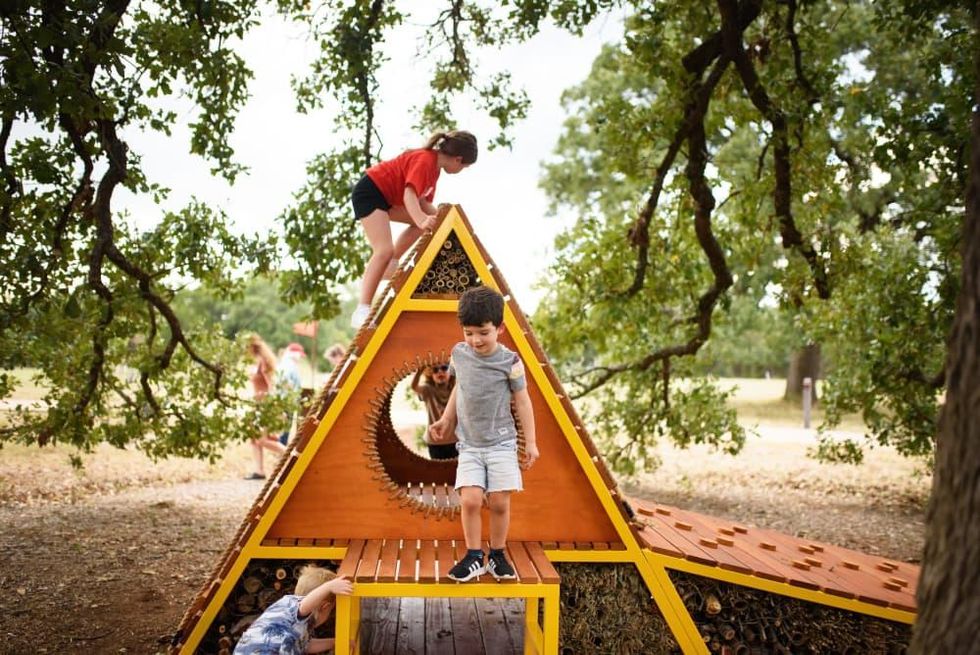Holding down the fort
Outdoor Fortlandia exhibit reminds Austinites the world is our playground
The Lady Bird Johnson Wildflower Center recognizes that some learning environments can be “places of no.” Museums have plenty of reasons to keep visitors’ hands off delicate art, but that can build a barrier between learners and the stimulus. The Please Touch Museum in Philadelphia teaches kids through tactile exhibits, and The Opera del Duomo Museum in Florence, Italy, addresses this issue for adults, too, with touchable replicas of some of its statues.
A nature center has a more abstract task: protecting nature without too much “no,” and keeping the shine on plants while still providing some man-made interactivity. Fortlandia, an exhibit open at the Wildflower Center through January 30, 2022, considers how we build spaces to enjoy nature, especially as children; we build forts.
The exhibit features eight fort areas, mostly created by local architects and designers, all interactive and focused on play. (Two more are on display at Lady Bird Lake.) For most, there is no one way to play, but visitors who like to play on paper are given field journals, including a map, imaginative prompts, and drawing space. The notes might also help identify a favorite exhibit, which can be voted on for a People’s Choice Award while the installations are up. When they come down, the designers can do whatever they choose with their forts, but many are donating them to schools or other community organizations.
Currently in the lead is The Critter Café by Jodi Bade. A mini food truck and stage made largely of salvaged materials, according to the fort’s description, gives kids their own chance at feeling invited into a very Austin-centric space. Bade cites the common play style of mimicking adults as inspiration for this cute Southwestern forest fantasy. With kitchen items inside and simple instruments on the stage, kids have all the cues they need to collaborate in surprisingly culturally relevant play.
Marketing coordinator for the Wildflower Center, Elizabeth Standley, takes a walk around the arboretum housing Fortlandia every day, noticing how visitors interact with the forts. She’s seen lots of performances on that miniature stage.
“Fortlandia and also our family garden, we like to describe as a place of yes,” Standley says. “Anything goes. It’s a place where children can really be independent and not too inhibited.”
One fort, the exhibit’s first-ever designed by a teenager, takes the idea of agency past freedom and into active collaboration. Jack Wilson drew a sketch of the Connect fort as a place to do just that, with reclining chairs on the bottom and bridges on top in a honeycomb-like weave made possible by Reach Architects and real estate developer StoryBuilt. Wilson, who has Down syndrome, made a place where people can connect — even if at first all they seem to have in common is an interest in the unique structure.
Taking fort-making back to the basics, there’s no need to collaborate with an architect to get the job done. One installment, Fort Build, lets visitors create their own structures using bamboo. Another, Builder Boards by Rusty Keeler, offers innovative building options using slotted boards that look like flat Lincoln Logs.
While the forts are mostly designed with children in mind, adults can also glean design inspiration and learn about sustainability. An offering from architecture and design firm ColorSpace and the Texas State Wildlife Society highlights simple conservation methods in a tiny A-frame that would look and function great in any backyard. While most playgrounds avoid bees and other crawlies (creepy and otherwise), this one creates little pockets for insects to live in. On top is a pollinator house full of tubes that just requires a little maintenance throughout the year for cleaning, winter storage, and predator control.
At night, things are even more all-ages, as silvana, an etched acrylic glass maze all the way from Spain, lights up. Starting December 2, the Luminations exhibit will cast nighttime lights on the forts and many trees while lining paths with luminarias (“little lanterns” in Spanish). Seasonal food and drinks will also be offered. Big glowing swings will give visitors somewhere to relax, and have been very popular on Instagram. Details for this year’s exhibit are still coming, but past years have also included audiovisual art.
“We make a celebration of the winter season rather than being holiday-specific,” says Standley. “We try and embrace the change of seasons because the plants are doing different things [during] different times of the year.”
Fortlandia is open now through the end of January. Entry is free for members, or included with regular admission to the Lady Bird Johnson Wildflower Center. Reserve a time to visit at wildflower.org.



